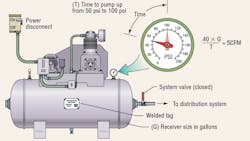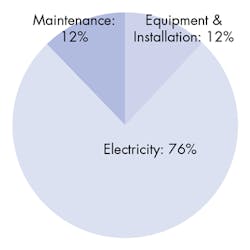Determine the Cost of Compressed Air for Your Plant
This file type includes high resolution graphics and schematics when applicable.
Most industrial facilities need some form of compressed air, whether for running a simple air tool or for more complicated tasks such as operation of pneumatic controls. A survey by the U.S. Department of Energy (DOE) showed that for a typical industrial facility, approximately 10% of the electricity consumed is for generating compressed air.
For some facilities, compressed-air generation may account for 30% or more of the electricity consumed. Compressed air is an on-site generated utility. Very often the cost of generation is not known; however, some companies use a value of 30 cents to 50 cents per 1,000 cubic feet of air.
Compressed air is one of the most expensive sources of energy in a plant. The overall efficiency of a typical compressed air system can be as low as 10% to 15%. For example, to operate a 1-hp air motor at 100 psig, approximately 7 to 8 hp of electrical power is supplied to the air compressor.
To calculate the cost of compressed air in your facility, use the following formula:
where hpb = compressor shaft horsepower (frequently higher than the motor nameplate horsepower—check equipment specification),
Percent time = percentage of time running at this operating level,
Percent full-load hpb = hpb as percentage of full-load hpb at this operating level, and
Motor efficiency = Efficiency of the electric motor at this operating level.
Example
A typical manufacturing facility has a 200 hp compressor (which requires 215 hpb) that operates for 6,800 hr annually. It is fully loaded 85% of the time (motor efficiency is 95%) and unloaded the rest of the time (25% full-load hpb and motor efficiency is 90%). The aggregate electric rate is $0.10/kWhr.
Cost when fully loaded:
Cost when partially loaded:
Annual energy cost = $97,584 + $4,544 = $102,128
For additional information on industrial energy efficiency measures, visit www.energy.gov/eere/amo/compressed-air-systems.






